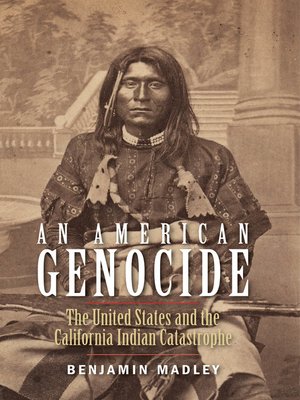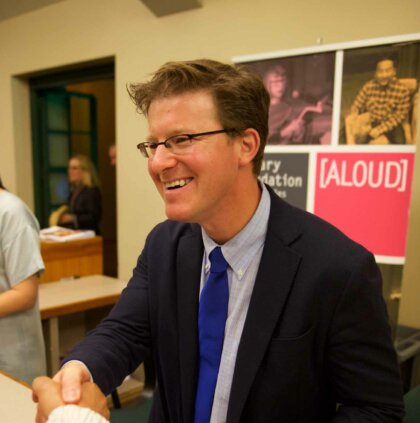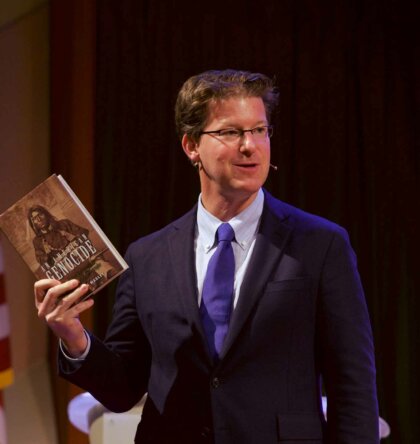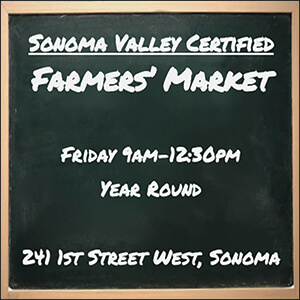The terrifying history of American genocide
“
“I began to study this history, and the further I went into it the more terrified I became by what I was seeing.”
By Justin Sharp | Special to The Sun –
Benjamin Madley is an activist-historian specializing in Native America and colonialism in world history, examined the systematic extermination of the California Indians in his book An American Genocide: The United States and the California Indian Catastrophe.
Madley presents a ‘Second Saturday’ lecture for the Sonoma Valley Historical Society on Saturday, March 12, at 2 p.m. For Zoom link write [email protected]
Madley became interested in the subject at a young age. Growing up in a cabin near rural Redding, California, he was acutely aware of the area was in Karuk country, both in small tactile ways like finding arrowheads in neighbors fields and in deeper more troubling ones relating to his fathers’ work as a school psychologist and private therapist.
“I saw firsthand at a quite young age this ongoing conflict between natives and newcomers… so at a pretty young age I began to think about what this meant, to colonize a place,” he recalled.

These questions were only heightened upon his move to Los Angeles, where he began to wonder where all the native people were despite being in what he would later learn was the most densely populated Indian city in the western US.
“I began to wonder where everybody went, and I began to study this history, and the further I went into it the more terrified I became by what I was seeing.”
What Madley was seeing was the horrific and systematic killing of thousands of Native Americans in California alone. The specific period of time he usually chooses to focus on (and the chronological setting of his book) is the time between 1846 and 1873, starting with the induction of California into the Union and ending with the final large-scale massacre of Native people.
During this 27 year period, the Native American population in California dropped from 150,000 to 30,000, meaning that on average four of every five people died. While dislocation, starvation, and disease all played significant roles in the death toll, so did abduction, battles, massacres, individual homicides, and mass death in forced confinement on reservations.
Much of the death was organized and paid for by the civil and federal government, be it in the form of propaganda, donations of munitions, reimbursements for militia expenses, or actual troops in the field.
All this evidence led Madley to an undeniably damning diagnosis: Native Americans were being targeted by State-sponsored genocide.
While not everyone agrees with the definition of genocide as set forth by the UN in 1948, it is made exceptional by the mere fact that it was agreed upon unanimously and with no abstentions, as well as being the legal rubric utilized in the trials of war criminals associated with genocides in Rwanda and Yugoslavia. While the convention does not allow for retroactive prosecutions for crimes committed before its institution, Madley says that the naming of what the United States committed as a proper genocide is a powerful tool in honestly understanding what happened.
While in recent years the U.S. school system has begun to require teaching on genocides like the Holocaust, the Armenian Genocide, and the Rape of Nanking, ideas of both Californian and American Exceptionalism have served to suppress the spread of the truth of the atrocities committed by the invaders against the Native Americans.
In contrast, the required education California youth receive on the subject happens in the 4th grade, a fact Madley thinks is definitely intentional as “there is only so much of this horror, of this profound pain that you can present to a nine- or ten-year-old child.”

Madley hoped for his book to accomplish a number of things in addition to a more robust education on the racial violence. “You have this dark cloud of genocide, but at the same time you have this unbelievable story or resilience and survival.”
In an effort to lay out the true scope of the Native Americans’ struggle, a large appendix of the book is dedicated to documenting every instance of killing Madley could compile. Despite the macabre premise, the section is very important to Madley, as he sees it as a memorial to all the lives lost, akin to the Yale Alumni War Memorial or Maya Lin’s Vietnam Veterans Memorial. He wanted a way to dignify the deaths of those otherwise largely forgotten to history; he hoped the book would spark a wider dialogue as well as public discourse.
And for a while it seemed like it would. Upon being published in 2016, An American Genocide met with widespread critical acclaim and received a cadre of awards. It was also publicly endorsed by Governor Jerry Brown, but the genocide was not officially recognized and named as such until 2019 when Governor Gavin Newsom issued a formal apology, stating, “It’s called a genocide, that’s what it was, a genocide. No other way to describe it, and that’s the way it needs to be described in the history books.”
Another impact of Madley’s work has been on the conversation of native rights and the postcolonial framework at large, is the way it serves to complement and contextualize the works of others in the field. While An American Genocide may seem limited in scope of both region and time, what the people of America did in California between 1846 and 1873 serves as a call both to action and humility.
Madley of course still feels there is much more work to be done, possibly by way of memorials and reparations. But it all begins with education, from the youngest Californian to the ones learning now from Madley himself, as he is currently an associate professor of history at UCLA. The work of an advocate-historian is never done.
Justin Sharp earned a degree in physics from Westmont College in the Spring of 2021. These days he streams on twitch.tv/JaygoVonEngel, playing games and worldbuilding for his books.
A version of this article first appeared on the Beyond the Single Story blog.




“And for a while it seemed like it would.” Could you follow up on this? Did we have a wider public discourse that was then abandoned?
Great article by the way. The author will be giving a Zoom lecture for the SV Historical Society, this year.
Thank you for this important reporting of our history.
One wonders why the City of Sonoma allows a statue of one of the perpetrators to be venerated in our Plaza. Even the St Francis Hotel, and other municipalities are removing those symbols.
The next generation would have a real understanding of American history if books like this were read in our schools. But, today we have a “white” parent revolt that will make sure that does not happen. Why are people so afraid of letting the next generation know the truth?